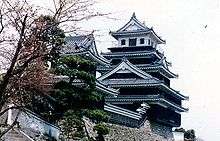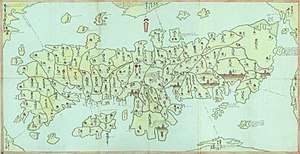Nakatsu Domain
Nakatsu Domain (中津藩, Nakatsu-han) was a Japanese domain of the Edo period. It was associated with Buzen Province in modern-day Ōita Prefecture on the island of Kyushu. The domain was centered at Nakatsu Castle in what is now Nakatsu, Ōita.

Nakatsu Castle
In the han system, Nakatsu was a political and economic abstraction based on periodic cadastral surveys and projected agricultural yields.[1] In other words, the domain was defined in terms of kokudaka, not land area.[2] This was different from the feudalism of the West.
List of daimyōs
The hereditary daimyōs were head of the clan and head of the domain.
![]()
![]()
- Nagatsugu
- Nagakatsu
- Nagatane
- Naganobu
- Nagasato
- Masashige
- Masaatsu
- Masaka
- Masao
- Masataka
- Masanobu
- Masamichi
- Masamoto
- Masayuki
gollark: What did I mean by this?
gollark: ????
gollark: Yes, apparently it exists because of an integration with some ancient company which exploded.
gollark: I see.
gollark: That does NOT apiologically functionize.
See also
- List of Han
- Abolition of the han system
- Fukuzawa Yukichi
References

- Mass, Jeffrey P. and William B. Hauser. (1987). The Bakufu in Japanese History, p. 150.
- Elison, George and Bardwell L. Smith (1987). Warlords, Artists, & Commoners: Japan in the Sixteenth Century, p. 18.
- Tadatoshi ruled Nakatsu after Tadaoki's retirement, but ruled it as part of the Kokura Domain
External links
![]()
- (in Japanese) Nakatsu on "Edo 300 HTML" (9 Oct. 2007)
This article is issued from Wikipedia. The text is licensed under Creative Commons - Attribution - Sharealike. Additional terms may apply for the media files.